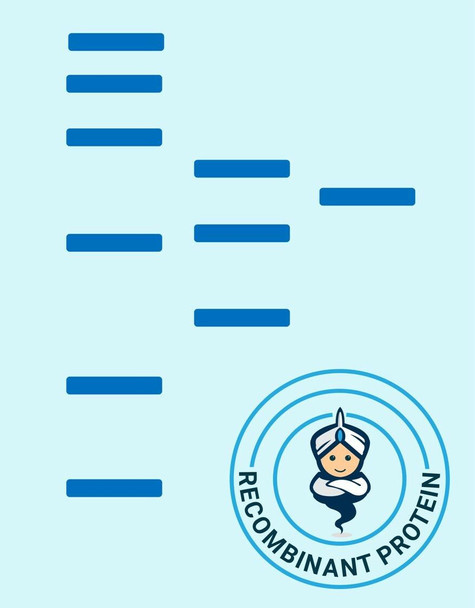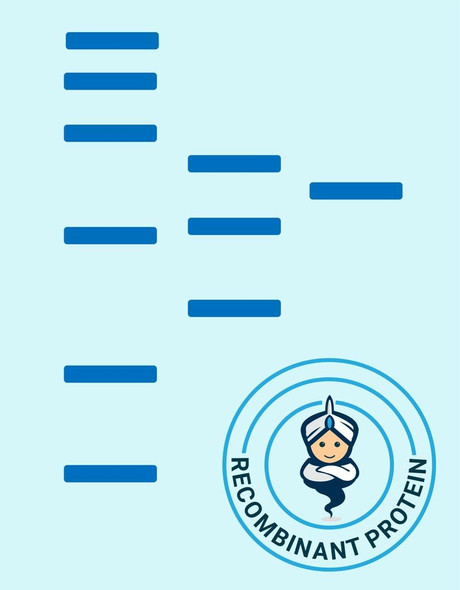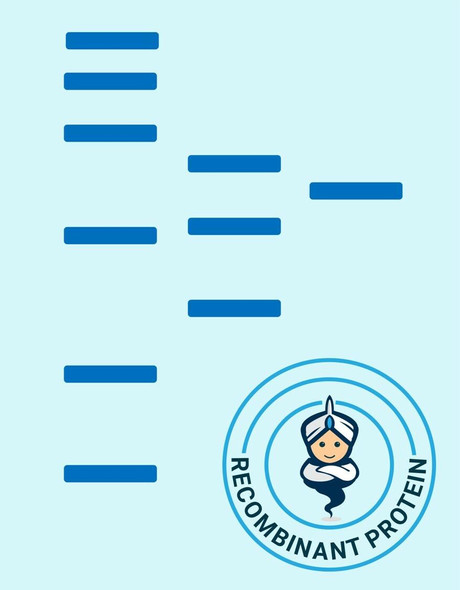Description
| Product Name: | Human CEA Recombinant Protein |
| Product Code: | RPPB3133 |
| Size: | 10µg |
| Species: | Human |
| Target: | CEA |
| Synonyms: | Carcinoembryonic Antigen Related Cell Adhesion Molecule 5, Carcinoembryonic Antigen-Related Cell Adhesion Molecule 5, Meconium Antigen 100, CEA, Carcinoembryonic Antigen, CD66e Antigen, CD66e, Carcinoembryonic antigen-related cell adhesion molecule 5, Carcinoembryonic antigen, CEA. |
| Source: | Sf9 Insect cells |
| Physical Appearance: | Sterile Filtered colorless solution. |
| Formulation: | CEA protein solution (0.5mg/ml) contains Phosphate Buffered Saline (pH 7.4) and 10% glycerol. |
| Stability: | Store at 4°C if entire vial will be used within 2-4 weeks. Store, frozen at -20°C for longer periods of time. For long term storage it is recommended to add a carrier protein (0.1% HSA or BSA).Avoid multiple freeze-thaw cycles. |
| Purity: | Greater than 95.0% as determined by SDS-PAGE. |
| Amino Acid Sequence: | KLTIESTPFN VAEGKEVLLL VHNLPQHLFG YSWYKGERVD GNRQIIGYVI GTQQATPGPA YSGREIIYPN ASLLIQNIIQ NDTGFYTLHV IKSDLVNEEA TGQFRVYPEL PKPSISSNNS KPVEDKDAVA FTCEPETQDA TYLWWVNNQS LPVSPRLQLS NGNRTLTLFN VTRNDTASYK�CETQNPVSAR RSDSVILNVL YGPDAPTISP LNTSYRSGEN LNLSCHAASN PPAQYSWFVN GTFQQSTQEL FIPNITVNNS GSYTCQAHNS DTGLNRTTVT TITVYAEPPK PFITSNNSNP VEDEDAVALT CEPEIQNTTY LWWVNNQSLP VSPRLQLSND NRTLTLLSVT RNDVGPYECG�IQNKLSVDHS DPVILNVLYG PDDPTISPSY TYYRPGVNLS LSCHAASNPP AQYSWLIDGN IQQHTQELFI SNITEKNSGL YTCQANNSAS GHSRTTVKTI TVSAELPKPS ISSNNSKPVE DKDAVAFTCE PEAQNTTYLW WVNGQSLPVS PRLQLSNGNR TLTLFNVTRN DARAYVCGIQ�NSVSANRSDP VTLDVLYGPD TPIISPPDSS YLSGANLNLS CHSASNPSPQ YSWRINGIPQ QHTQVLFIAK ITPNNNGTYA CFVSNLATGR NNSIVKSITV SASGTSPGLS ALEHHHHHH |
Carcinoembryonic antigen (CEA) is a glycoprotein present in fetal digestive-tract tissues; it�s involved in cell adhesion. The production of CEA stops before birth. CEA is called tumor marker since its elevated levels are found in the serum from individuals with colorectal, gastric, pancreatic, lung and breast carcinomas and in heavy smokers.There are also benign conditions that elevate CEA levels such as smoking, infection, inflammatory bowel disease, pancreatitis, cirrhosis of the liver, and some benign tumors (in the equivalent organs which have cancers with elevated CEA). Typically, higher levels of CEA are found in men, smokers, and older individuals.The presence of CEA assists in screening, in evaluating recurrent or disseminated disease, and in determining the success of surgical removal of malignant tumors.CEA levels can be used as indicators of treatment success. The normal values range from 0.0 to 2.5 ng/ml of serum (from blood), in non-smokers, a greater amount than that may be suggestive of cancer. Levels above 20 ng/ml before treatment are associated with cancer which has already metastasized. Benign conditions do not usually cause a CEA increase over 10 ng/ml.�The high levels of CEA should return to normal after successful therapy, however if during follow up there�s an elevation in CEA levels it indicates a recurrence of tumor.Carcinoembryonic antigen family belongs to the immunoglobulin superfamily; it consists of 29 genes, 18 of which are normally expressed.
CEA Human Recombinant produced in Sf9 Baculovirus cells is a single, glycosylated polypeptide chain containing 659 amino acids (35-685a.a.) and having a molecular mass of 72.3kDa (Molecular size on SDS-PAGE will appear at approximately 70-150kDa). CEA is expressed with an 8 amino acids His tag at C-Terminus and purified by proprietary chromatographic techniques.
| UniProt Protein Function: | CEACAM5: Cell surface glycoprotein that plays a role in cell adhesion and in intracellular signaling. Receptor for E.coli Dr adhesins. Homodimer. Binding of E.coli Dr adhesins leads to dissociation of the homodimer. Found in adenocarcinomas of endodermally derived digestive system epithelium and fetal colon. Belongs to the immunoglobulin superfamily. CEA family. |
| UniProt Protein Details: | Protein type:Membrane protein, integral; Immunoglobulin superfamily; Membrane protein, GPI anchor Chromosomal Location of Human Ortholog: 19q13.1-q13.2 Cellular Component: basolateral plasma membrane; integral to plasma membrane Molecular Function:identical protein binding; protein homodimerization activity Biological Process: homotypic cell-cell adhesion; negative regulation of apoptosis |
| NCBI Summary: | Members of the CEACAM subfamily, including CEACAM5, belong to the CEA gene family. For general information on the CEA gene family, see CEACAM1 (MIM 109770).[supplied by OMIM, Oct 2009] |
| UniProt Code: | P06731 |
| NCBI GenInfo Identifier: | 317373456 |
| NCBI Gene ID: | 1048 |
| NCBI Accession: | P06731.3 |
| UniProt Secondary Accession: | P06731,H9KVA7, |
| UniProt Related Accession: | P06731 |
| Molecular Weight: | 76,795 Da |
| NCBI Full Name: | Carcinoembryonic antigen-related cell adhesion molecule 5 |
| NCBI Synonym Full Names: | carcinoembryonic antigen-related cell adhesion molecule 5 |
| NCBI Official Symbol: | CEACAM5�� |
| NCBI Official Synonym Symbols: | CEA; CD66e�� |
| NCBI Protein Information: | carcinoembryonic antigen-related cell adhesion molecule 5; meconium antigen 100 |
| UniProt Protein Name: | Carcinoembryonic antigen-related cell adhesion molecule 5 |
| UniProt Synonym Protein Names: | Carcinoembryonic antigen; CEA; Meconium antigen 100 |
| Protein Family: | Colicin |
| UniProt Gene Name: | CEACAM5�� |
| UniProt Entry Name: | CEAM5_HUMAN |









